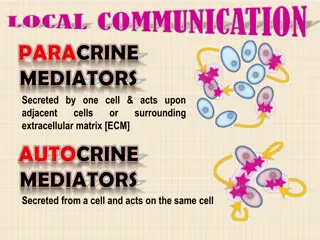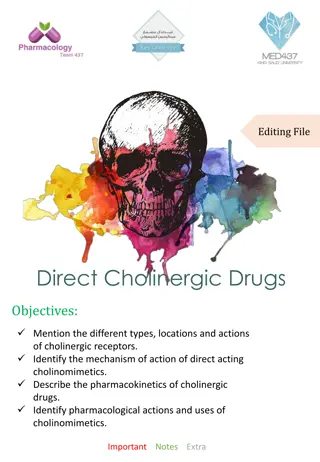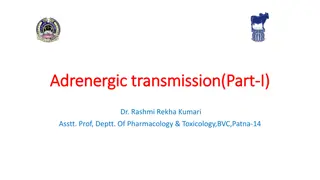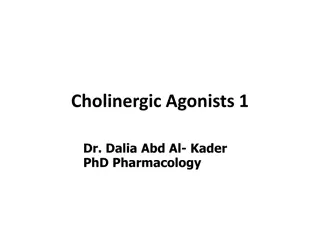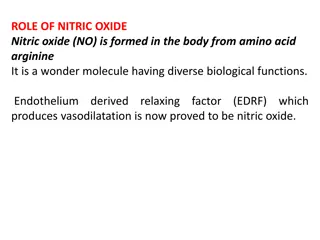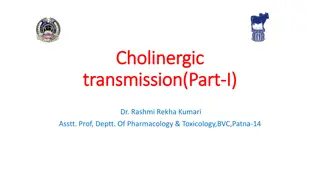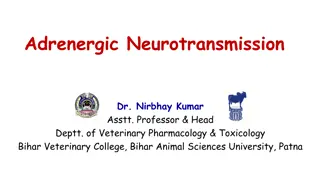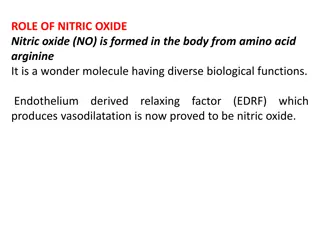Understanding Histamine: Synthesis, Release, and Effects in the Body
Histamine, a potent chemical mediator, is synthesized and stored in various cells like mast cells and basophils. It is involved in allergic reactions, immune responses, and neurotransmission in the central and autonomic nervous systems. This substance is released in response to stimuli like tissue i
1 views • 39 slides
Understanding Cholinergic Drugs: Receptors, Actions, and Pharmacology
Learn about the types, locations, and actions of cholinergic receptors, the mechanism of action of direct-acting cholinomimetics, pharmacokinetics of cholinergic drugs, and the pharmacological actions and uses of cholinomimetics. Explore the roles of nicotinic and muscarinic receptors in the nervous
4 views • 12 slides
Understanding Adrenergic Transmission and Catecholamine Synthesis
Adrenergic transmission involves the release of neurotransmitters such as norepinephrine, dopamine, and epinephrine at synapses or neuroeffector junctions. These neurotransmitters, known as catecholamines, play crucial roles in transmitting impulses in the sympathetic nervous system and central nerv
0 views • 14 slides
Understanding Cholinergic Neurons and Agonists in Pharmacology
Cholinergic neurons play a vital role in neurotransmission by utilizing acetylcholine (ACh) as a neurotransmitter. This neurotransmission involves steps like synthesis, storage in vesicles, release, receptor binding, degradation, and recycling of choline and acetate. Choline acetyltransferase cataly
0 views • 30 slides
Role of Nitric Oxide in the Body: Functions, Formation, and Clinical Aspects
Nitric oxide (NO), a vital molecule formed from arginine, plays diverse roles in the body including vasodilation, neurotransmission, platelet regulation, and immune response. Its formation involves a complex enzyme called nitrogen oxide synthase. Various inhibitors and clinical implications, such as
0 views • 19 slides
Understanding Cholinergic Transmission in Neurohumoral Signaling
Cholinergic transmission plays a crucial role in neurohumoral signaling, involving the release of acetylcholine at synapses and neuroeffector junctions. Dr. Rashmi Rekha Kumari explains the synthesis, storage, release, and catabolism of acetylcholine, highlighting the role of choline acetyl transfer
0 views • 11 slides
Understanding Adrenergic Neurotransmission in Veterinary Pharmacology
Adrenergic neurotransmission, mediated by norepinephrine, dopamine, and epinephrine, plays a crucial role in various physiological processes. This process involves synthesis, storage, release, and termination of catecholamines like norepinephrine and epinephrine. The intricate mechanisms of neurotra
0 views • 12 slides
Role of Nitric Oxide in Biological Functions and Health
Nitric oxide (NO), a vital molecule formed in the body from arginine, plays diverse roles such as vasodilation, neurotransmission, platelet inhibition, and immune response mediation. It is essential for regulating blood flow, maintaining blood pressure, and muscle relaxation. Various inhibitors impa
0 views • 26 slides
